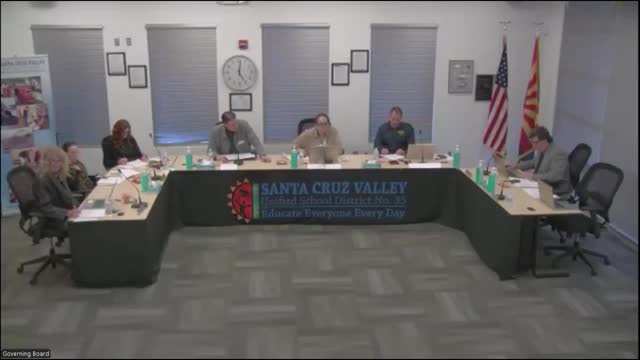Calabasas principal cites AZELLA gains, sets 5% math-proficiency target
January 05, 2025 | Santa Cruz Valley Unified District, School Districts, Arizona
This article was created by AI summarizing key points discussed. AI makes mistakes, so for full details and context, please refer to the video of the full meeting. Please report any errors so we can fix them. Report an error »

Principal John Fanning told the Santa Cruz Valley Unified School District No. 35 governing board on Dec. 10 that Calabasas School posted measurable gains on Arizona’s English-language proficiency assessment and is pursuing a plan to raise math proficiency by 5% next year.
Fanning said Calabasas earned four of the AZELLA proficiency points available this year and was 0.01 percentage points from a fifth point. He highlighted a sharp rise in first-grade AZELLA proficiency — from 28% to 72% year over year — and said the school increased the share of students who moved up at least one proficiency level from 24% last year to 40% this year.
The results matter because roughly 40% of Calabasas students are enrolled in the district’s Structured English Immersion (SEI) program, Fanning told the board. He said the school is intentionally focusing on students at the “minimally proficient” level to push them up a band and also continuing supports for already-proficient students.
Key actions and programs Fanning described include monthly data meetings for all nine grade levels, a structured “pride” intervention block at middle school that uses elective teachers to push into classrooms as additional adults for small-group instruction, and use of benchmark assessments (MAP, iReady and local benchmarks) to form instructional groupings. At the elementary level, he said teachers are implementing a scripted early literacy program (DIBELS) and a new K–5 literacy program he called powerful for accelerating growth.
Fanning identified math as the district’s primary persistent weakness. The school set a concrete goal to increase math proficiency by 5% and said coaches and grade-level teams will monitor flexible small-group instruction, groupings and monthly progress checks. He described incentives and celebrations — for example, middle-school students who show monthly growth visit elementary classrooms — as part of a broader effort to motivate learners.
Board members praised the presentation and asked questions about family engagement, attendance and supplemental digital tools. Fanning described family data nights (one offered in English and Spanish) that explain SEI and the importance of testing, and said the school ran its highest-ever participation rate on required tests this year. Board discussion later in the meeting addressed supplemental online resources such as Khan Academy and the Arizona Department of Education’s Conmigo platform for grades 6–12; district staff said Conmigo access is available through student Clever accounts and training is rolling out.
Fanning credited instructional coaches and campus staff by name for implementing the changes and said the school expects continued improvement though “maybe not tomorrow.”
The presentation ran about an hour and drew several rounds of board questions; the board did not take formal action on the item.
Calabasas’ immediate next steps, as described to the board, are to continue monthly data reviews, refine small-group math interventions, maintain focus on chronic absenteeism and build on AZELLA strategies that yielded gains in early grades.
Fanning said Calabasas earned four of the AZELLA proficiency points available this year and was 0.01 percentage points from a fifth point. He highlighted a sharp rise in first-grade AZELLA proficiency — from 28% to 72% year over year — and said the school increased the share of students who moved up at least one proficiency level from 24% last year to 40% this year.
The results matter because roughly 40% of Calabasas students are enrolled in the district’s Structured English Immersion (SEI) program, Fanning told the board. He said the school is intentionally focusing on students at the “minimally proficient” level to push them up a band and also continuing supports for already-proficient students.
Key actions and programs Fanning described include monthly data meetings for all nine grade levels, a structured “pride” intervention block at middle school that uses elective teachers to push into classrooms as additional adults for small-group instruction, and use of benchmark assessments (MAP, iReady and local benchmarks) to form instructional groupings. At the elementary level, he said teachers are implementing a scripted early literacy program (DIBELS) and a new K–5 literacy program he called powerful for accelerating growth.
Fanning identified math as the district’s primary persistent weakness. The school set a concrete goal to increase math proficiency by 5% and said coaches and grade-level teams will monitor flexible small-group instruction, groupings and monthly progress checks. He described incentives and celebrations — for example, middle-school students who show monthly growth visit elementary classrooms — as part of a broader effort to motivate learners.
Board members praised the presentation and asked questions about family engagement, attendance and supplemental digital tools. Fanning described family data nights (one offered in English and Spanish) that explain SEI and the importance of testing, and said the school ran its highest-ever participation rate on required tests this year. Board discussion later in the meeting addressed supplemental online resources such as Khan Academy and the Arizona Department of Education’s Conmigo platform for grades 6–12; district staff said Conmigo access is available through student Clever accounts and training is rolling out.
Fanning credited instructional coaches and campus staff by name for implementing the changes and said the school expects continued improvement though “maybe not tomorrow.”
The presentation ran about an hour and drew several rounds of board questions; the board did not take formal action on the item.
Calabasas’ immediate next steps, as described to the board, are to continue monthly data reviews, refine small-group math interventions, maintain focus on chronic absenteeism and build on AZELLA strategies that yielded gains in early grades.
View full meeting
This article is based on a recent meeting—watch the full video and explore the complete transcript for deeper insights into the discussion.
View full meeting
